
The DeFi landscape is innovative but remains a fragmented Islands of specialized protocols. A user seeking to engage with a new token must often navigate a disjointed journey: discovering the token on a launchpad like pump.fun, swapping it on an Automated Market Maker (AMM) like Uniswap, and finally, trading its derivatives on a separate perpetuals exchange such as dYdX. This multi-platform shuffle introduces significant user friction, capital inefficiency, and a degraded user experience.
I. GTE's Unified Solution
Global Token Exchange (GTE) is engineered to solve this precise problem. It presents itself as a vertically integrated, non-custodial "SuperApp" for trading, designed to unify the entire token lifecycle on a single, high-performance platform. The core value proposition is to deliver the speed, liquidity, and seamless experience of a centralized exchange like Binance, while retaining the foundational DeFi principles of security, transparency, and user-controlled custody.
II. Market Validation & Funding

GTE has successfully raised a total of around $26 million across several funding rounds. This includes a $1.5 million pre-seed round in July 2024, a $6.94 million seed round in October 2024, a $2.5 million public sale in January 2025, and a decisive $15 million Series A led exclusively by the venture capital firm Paradigm in June 2025. The participation of Paradigm, a premier crypto-native investment firm, alongside other notable investors such as Wintermute, GSR, and Robot Ventures, confers a significant degree of institutional confidence in GTE's technological approach and long-term strategy.
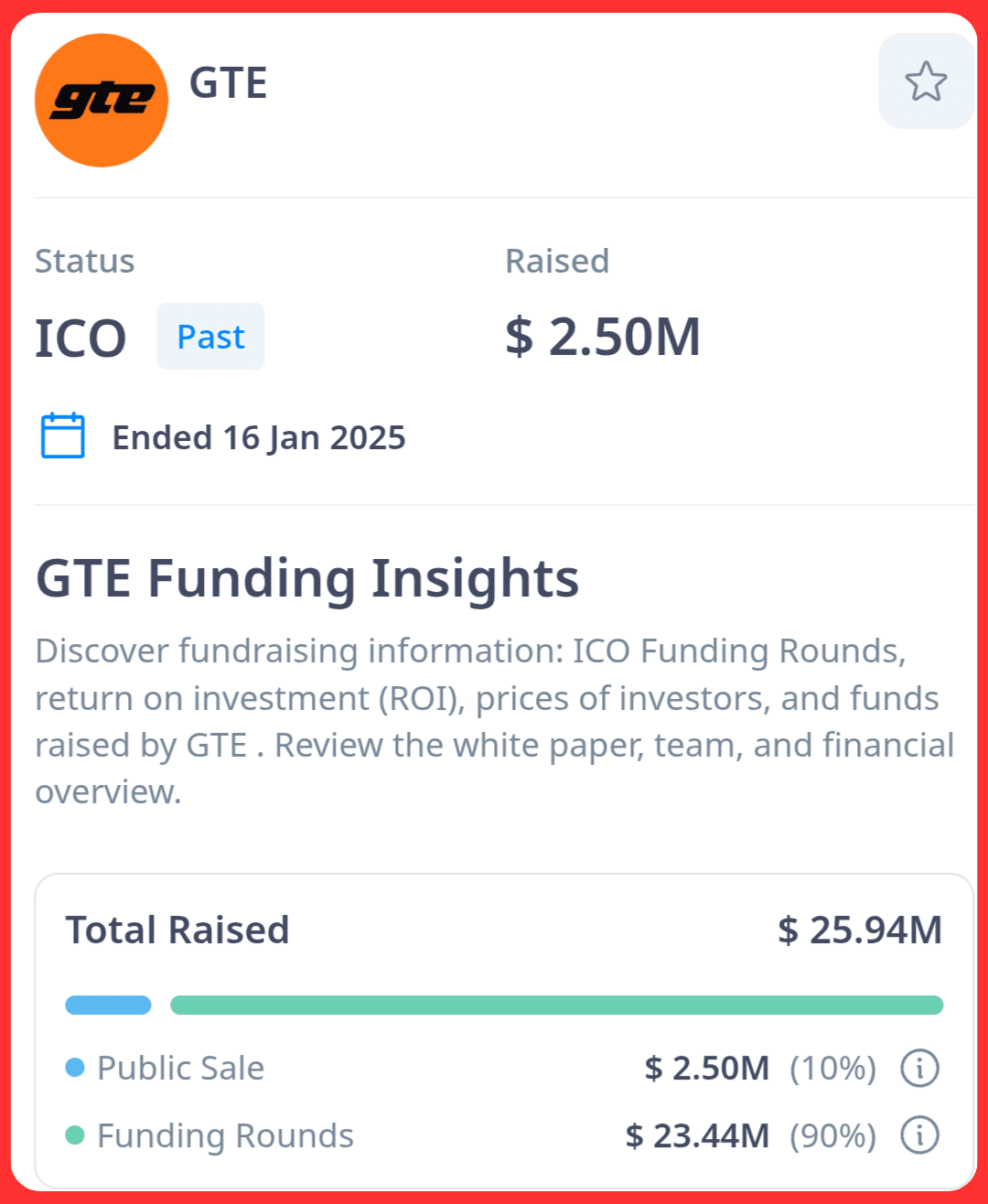
Beyond institutional backing, GTE has demonstrated impressive grassroots traction. The platform's testnet, launched in early 2025, has already attracted over 700,000 users. This high level of engagement not only serves to battle-test the protocol under a significant load but also cultivates a large, invested community. This community is likely anticipating a potential retroactive airdrop, a proven growth-hacking strategy in the Layer-2 space that can bootstrap a network with a broad and active user base upon its mainnet launch.
III. GTE's Integrated Architecture

GTE's core innovation lies in its vertically integrated architecture, which covers the entire lifecycle of a token on a single, high-performance platform. This design philosophy manifests in two primary engines: a hybrid liquidity model and a comprehensive token launch system.
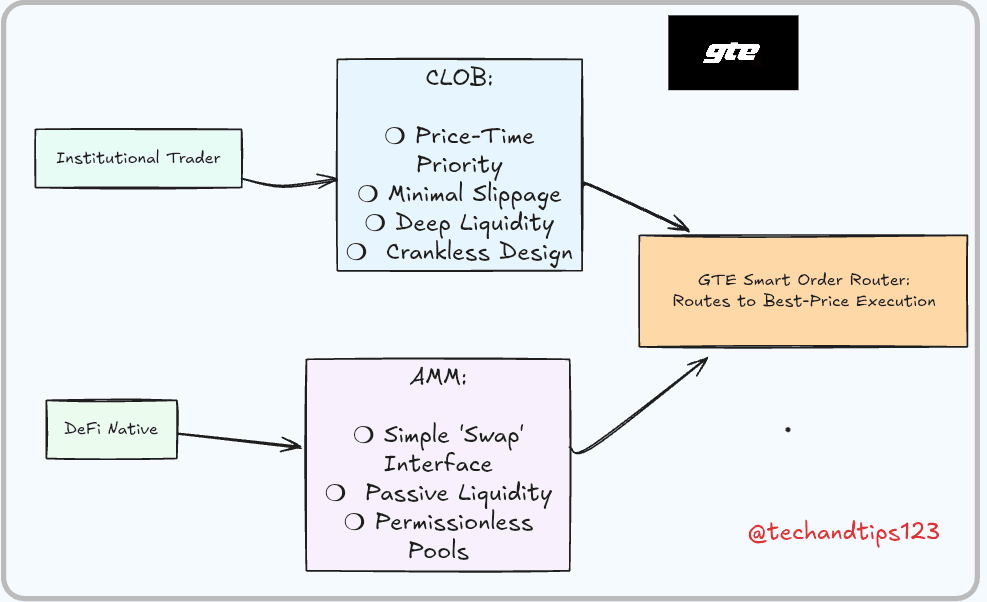
A. Hybrid Liquidity Engine: CLOB + AMM
Central Limit Order Book (CLOB):
At the heart of GTE's offering for professional traders is a fully on-chain CLOB. This mechanism matches buy and sell orders based on price-time priority, mirroring the functionality of traditional financial exchanges like the NYSE and top-tier CEXs. This model is preferred by market makers and algorithmic traders who require precise order execution, the ability to place limit orders, and transparent price discovery.Automated Market Maker (AMM):
To serve the broader DeFi community accustomed to the simplicity of "swap" interfaces, GTE also incorporates a traditional AMM. This allows users to trade assets against liquidity pools, offering a straightforward mechanism for passive liquidity provision and simple token exchanges.Best-Price Aggregator:
To unify these two liquidity sources, GTE employs a smart routing system. This aggregator scans all available trading venues on the underlying MegaETH blockchain, that includes GTE's own CLOB and AMM, as well as any other DEXs that may launch on the network. Ensuring the guarantee that every user receives the optimal execution price for their trade. This removes the burden of manual price comparison from the user and ensures capital efficiency across the ecosystem.
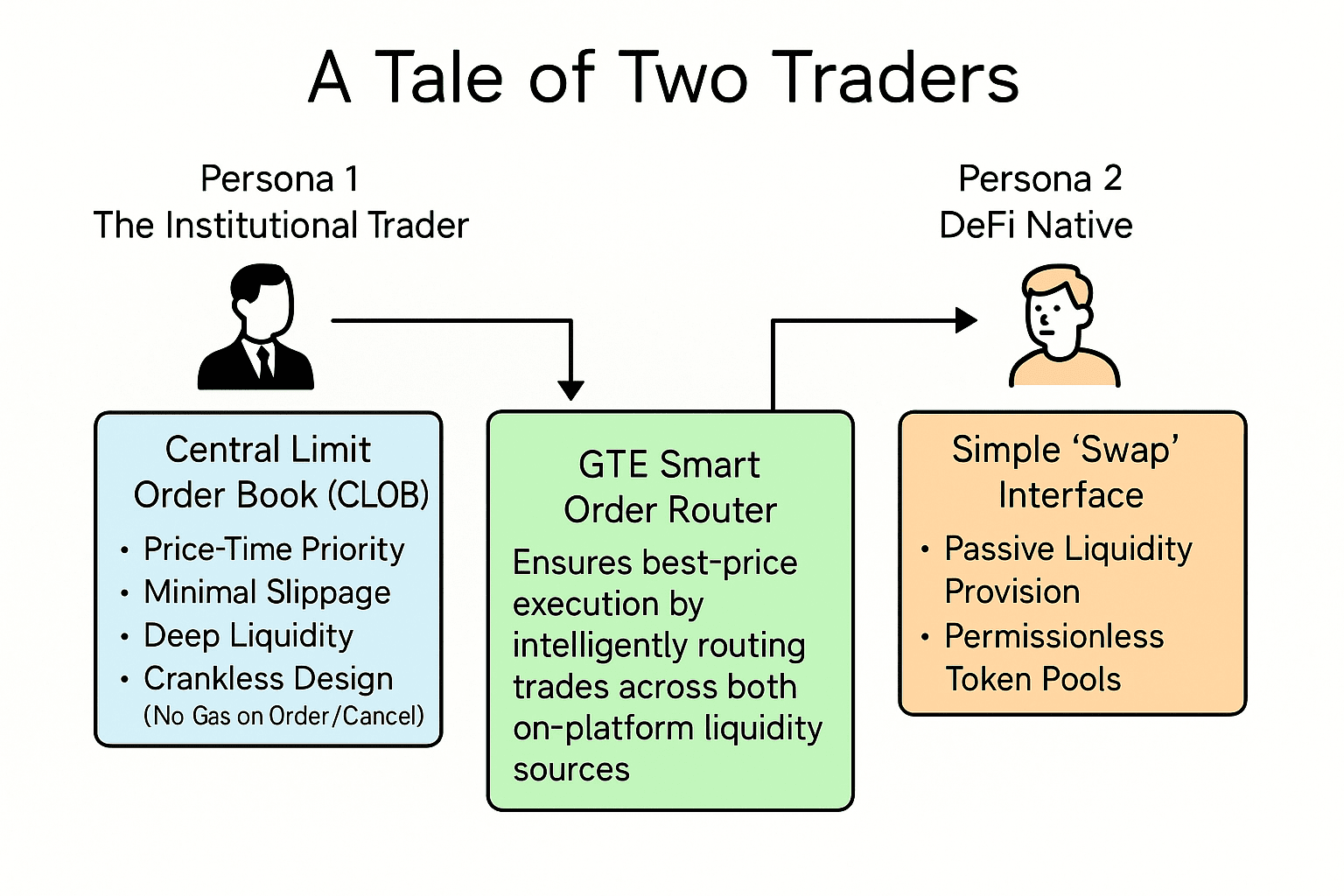
B. Token Lifecycle Engine: Takeoff & Launchpad
GTE Takeoff:
This is a permissionless token launcher designed for emerging projects and developers. It utilizes a bonding curve mechanism, an automated pricing algorithm that adjusts a token's price based on its supply. When a new token is created via Takeoff, this bonding curve automatically bootstraps its initial liquidity within GTE's AMM system. This is a highly capital-efficient method for new projects to establish a liquid market without requiring massive upfront investment from market makers.GTE Launchpad:
For more established protocols or projects planning a large-scale Token Generation Event (TGE), GTE offers a curated Launchpad. This venue provides a more structured, deeply liquid, and high-visibility environment for major token launches, catering to projects that have already garnered significant community and investor interest.
This integrated architecture creates a powerful, self-reinforcing flywheel that is GTE's primary strategic advantage. By controlling the entire value chain, GTE can capture users and assets at their point of origin and retain them throughout their trading lifecycle. A new token can be born on Takeoff, find its initial price and user base in the AMM, mature into a deeply liquid asset on the CLOB, and eventually become a candidate for a perpetuals contract—all within a single, unified platform. Each stage seamlessly feeds into the next, creating a sticky ecosystem that minimizes capital fragmentation and provides no incentive for users or assets to migrate to competing, specialized protocols. This stands in stark contrast to the current DeFi paradigm, where value and liquidity are scattered across a multitude of disconnected venues.
IV. How GTE Achieves CEX-Level Performance

The remarkable performance promised by GTE is not an inherent feature of the exchange itself, but rather a direct consequence of its exclusive foundation on MegaETH, a novel Layer-2 (L2) blockchain engineered for hardware-limit performance. Understanding GTE's capabilities requires a deep dive into the architecture of its underlying chain.
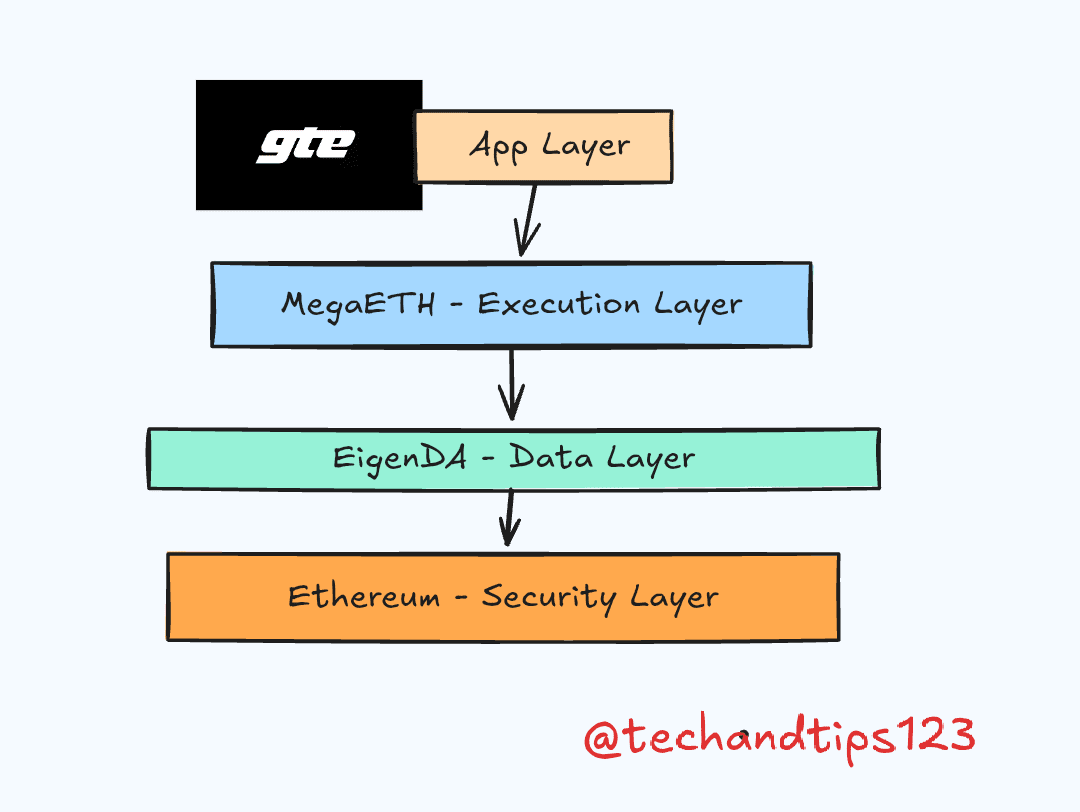
❍ Real-Time Blockchain Architecture
MegaETH is an Ethereum Virtual Machine (EVM)-compatible L2 designed to function as a "real-time blockchain". It targets staggering performance metrics, including a throughput of over 100,000 transactions per second (TPS) and block times as low as 10 milliseconds, with a future goal of achieving 1-millisecond latency. This represents a fundamental paradigm shift from the seconds-to-minutes finality common on other blockchains, including established L2s like Arbitrum and Optimism.
This extreme performance is achieved through a deliberate and significant architectural trade-off: the use of a single, centralized sequencer for transaction ordering and execution. While this model introduces a single point of failure for liveness, it eliminates the latency overhead associated with distributed consensus mechanisms.
MegaETH's design philosophy, inspired by writings from Ethereum co-founder Vitalik Buterin, posits that such a system can be "acceptably trustless" by separating execution from security. In this model, the centralized sequencer handles speed, while security and final settlement are anchored to the Ethereum base layer.
❍ The "Crankless" CLOB Advantage
The primary challenge for on-chain order book exchanges has always been gas costs. On most blockchains, every single action: placing an order, canceling an order, updating an order is a transaction that incurs a fee. This fee acts as a "crank" that market makers must constantly turn, making high-frequency strategies and tight bid-ask spreads economically unfeasible.
MegaETH's architecture, with its extremely low and predictable gas fees, effectively removes this crank. Market makers on GTE can place and cancel thousands of orders per second without facing prohibitive costs, allowing them to provide liquidity with an efficiency that rivals traditional financial markets.
To understand this, imagine two market makers at competing fruit stands. The first, operating on a legacy DEX, must pay the market owner $1 every time they want to change the price of their apples. They will naturally be hesitant to make frequent, small adjustments. The second market maker, operating on GTE, can change their price for free, a thousand times a minute. Their prices will always be more competitive and more accurately reflect real-time supply and demand, leading to a more efficient market for all participants.
> Explain Like I'm Five : What Are CLOBs
❍ EigenDA: Scalable Data Layer
A high-throughput L2 like MegaETH generates a colossal volume of transaction data. Posting this data directly to the Ethereum L1 for data availability (DA) would be astronomically expensive, undermining the entire purpose of the L2 scaling solution. To solve this, MegaETH utilizes EigenDA, a specialized data availability layer built on top of EigenLayer.
EigenDA is designed to handle massive data loads at a fraction of the cost of Ethereum L1. MegaETH's choice of EigenDA over competitors like Celestia was driven by a critical need for bandwidth. According to MegaETH's team, their architecture is "too fast" for most existing infrastructures, and EigenDA's confirmed throughput of 15 Mb/s far exceeds Celestia's capacity of approximately 1.33 Mb/s, making it the only viable option to support MegaETH's data output.
To understand this simply : if the MegaETH sequencer is a Formula 1 car, it requires a massive, dedicated runway (EigenDA) to operate at full speed. Attempting to use a smaller, public road (like posting all data to Ethereum L1) would be impossible and would completely negate its performance advantages.
V. Competitive Advantages Over Legacy DEXs
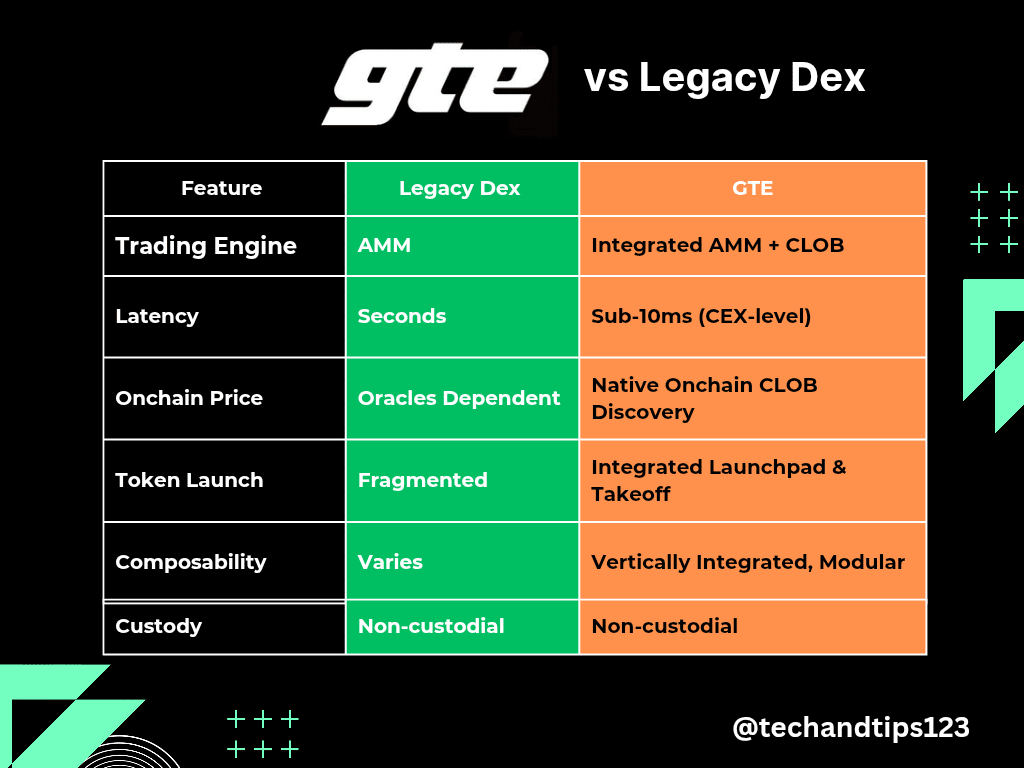
Speed and Performance: Legacy DEXs, even Uniswap and dYdX, often face high latency and transaction costs in periods of congestion. GTE sets a new standard—speed on par with CEXs, eliminating the biggest friction for market makers and institutional traders.
Full Onchain Price Discovery: GTE’s onchain CLOB aspires to bring real-time, organic price discovery to the blockchain, eliminating reliance on external oracles, and making decentralized derivatives and perps more robust and capital-efficient.
User Control and Transparency: 100% non-custodial, every trade, every order, every launch is secured by the blockchain—no blind trust in an exchange operator, no risk of insolvency or mismanagement, and transparent records for all activity.
Vertically Integrated & Permissionless Innovation: Traditional DEXs force projects and traders to stitch together disparate tools. GTE’s all-in-one design makes issuing tokens, trading spot and perps, and bootstrapping liquidity seamless. Anyone can launch a token permissionlessly via the Takeoff product and catalyze novel DeFi experiments.
Composability and Ecosystem Growth: Operating on MegaETH, GTE benefits from DeFi’s composability, allowing deeper integrations, ecosystem-wide liquidity aggregation, and synergy with other onchain applications. It differentiates itself from “app chain” models (like Hyperliquid or dYdX) by remaining open, permissionless, and accessible to builders and users alike.
Bridging Retail and Institutional Users: With low latency and deep liquidity mechanisms, GTE can welcome both algorithmic market makers (traditionally CEX-bound) and average DeFi users, shrinking the “experience gap” between decentralized and centralized trading.

